1921
100 Years of Women in Irish Politics and Public Life
The Pop-Up Museum showcasing 100 years of Women in Politics and Public Life was launched in December 2018 to mark the centenary of the introduction of voting rights for women.
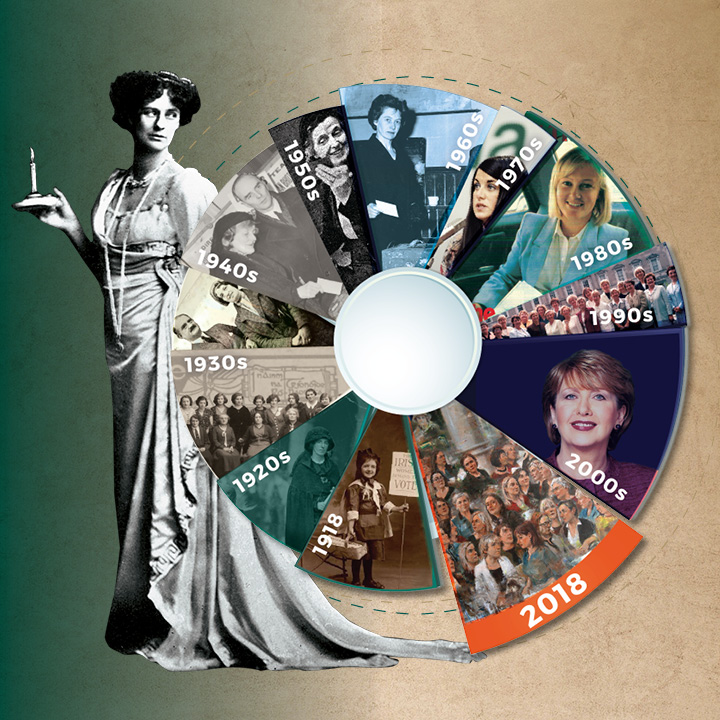
1921
The Pop-Up Museum showcasing 100 years of Women in Politics and Public Life was launched in December 2018 to mark the centenary of the introduction of voting rights for women.

This 100 Year Journey was compiled to highlight the complexity and diversity of women’s experience over the past 100 years.
This is not a definitive list but it is intended that this will be a living document and we encourage people to engage with the project and provide suggestions for inclusion.
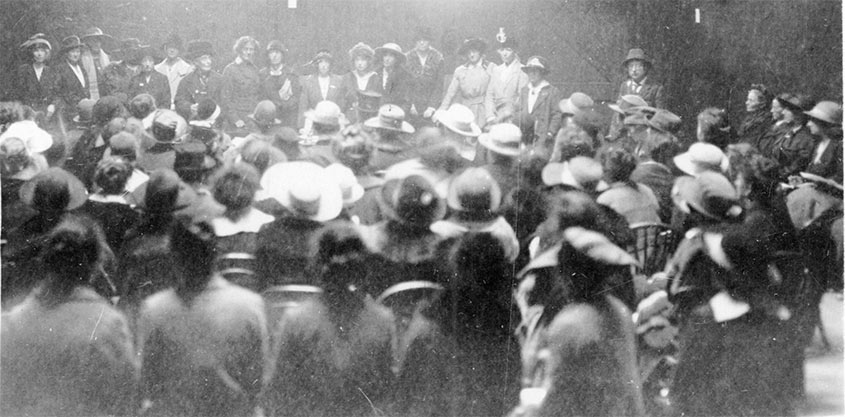
In the local authority elections in January 1920, forty-three women were elected to city, county and borough councils. WT Cosgrave, Minister for Local Government, oversaw a municipal administration whose allegiance was now changing from the British parliament to Dáil Éireann.
Arthur Griffith, Minister for Home Affairs, set about establishing the justice system including the Dáil Courts. Kathleen Clarke was a Judge in North Dublin. She was also an Alderman on Dublin Corporation for the Woodquay and Mountjoy Wards.
Minister for Finance Michael Collins raised a loan to finance the new administration. He promoted the sale of Dáil bonds by making a film, in which the relatives of those executed for their part in the 1916 Rising took a prominent part. Margaret Pearse (mother of Patrick and William) was included and filming took place at Pearse’s school, St Enda’s in Rathfarnham.
Cathal Brugha was Minister for Defence. A military campaign was waged against The Crown. The revolutionary forces became known as the Irish Republican Army (IRA). It was a guerrilla war, with units formed as brigades and ‘flying columns’. Food and shelter for the soldiers were provided by sympathisers.
Two of Ireland’s early women doctors, Dr Kathleen Lynn and Dr Ada English sheltered and treated the wounded.
As the war intensified, the British significantly expanded recruitment into the police force via a new special reserve. The new recruits became known as the Black and Tans and the Auxiliaries. In an increasingly bitter struggle, retaliation by Crown Forces included constant raids of homes and businesses and attacks on mills, creameries and factories. This culminated in the burning of Cork City.
The British administration began to intern both men and women (a Cumann na mBan report recorded only 50 of their members were incarcerated at this time including Dr Ada English). Countess de Markievicz was also back in prison.
Many public representatives were also incarcerated, including the Lord Mayor of Cork, Terence MacSwiney, who died in Brixton Prison in London on 25 October 1920 after 74 days on hunger-strike in protest at his arrest. His eldest sister Mary had co-ordinated the press interest in the story, which attracted international attention. When Éamon de Valera returned from the U.S. fundraising and publicity tour in December 1920 he asked Mary MacSwiney to continue his work there, publicising the fight for Irish self-determination.
On the 23 December 1920 the Government of Ireland Act became law. This allowed for Northern Ireland and Southern Ireland to have their own parliaments, but Ireland would remain part of the British Empire and the Monarch would remain the Head of State.
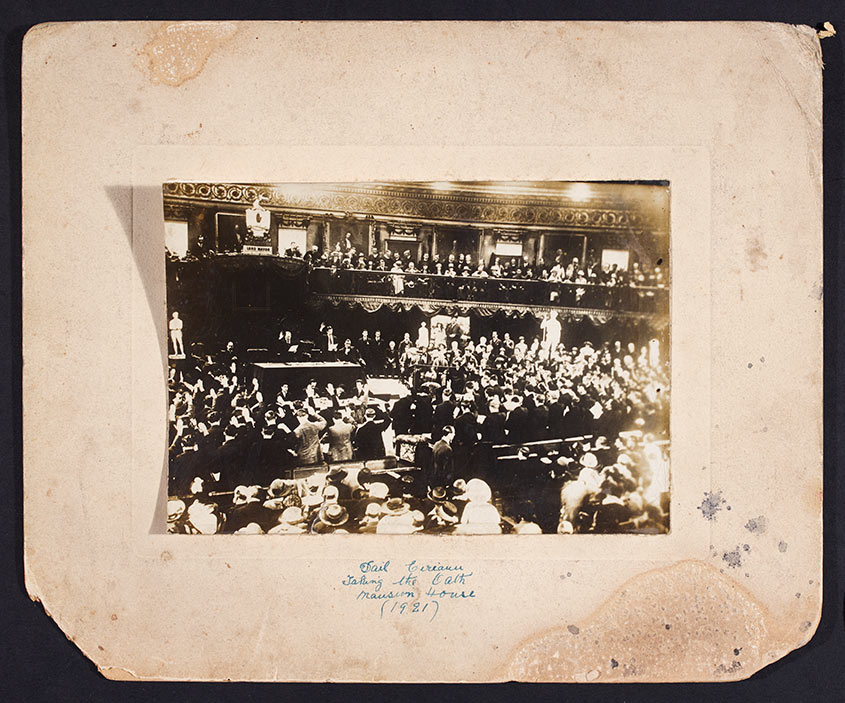
In May 1921 elections were held under the Government of Ireland Act. Sinn Féin took part in the election but refused to recognise the two parliaments. Instead, they formed the 2nd Dáil.
Five more women joined Countess de Markievicz: Kathleen Clarke, Dr Ada English, Mary MacSwiney, Kate O’Callaghan and Margaret Pearse. Kate O’Callaghan had come to public attention with her publication on the ‘Limerick Curfew Murders’ detailing how her husband had been shot and killed in March 1921.
The Sex Disqualification (Removal) Act 1919 gave women access to careers in law, veterinary surgery and the higher civil service from which they had hitherto been debarred.
Frances Christian Kyle of Belfast and Averil Katherine Statter Deverell of Greystones, County Wicklow, both Trinity Law Graduates, were the first women called to the Irish Bar on November 1st, 1921. They had been admitted to King’s Inns in January 1920.
Frances Kyle is recorded as the first woman admitted to the Bar. She was also the first woman to receive the John Brooke Scholarship. Deverell became the first woman to practice at the bar. Her twin brother William Berenger Slatter Deverell was also called to the bar the same day.
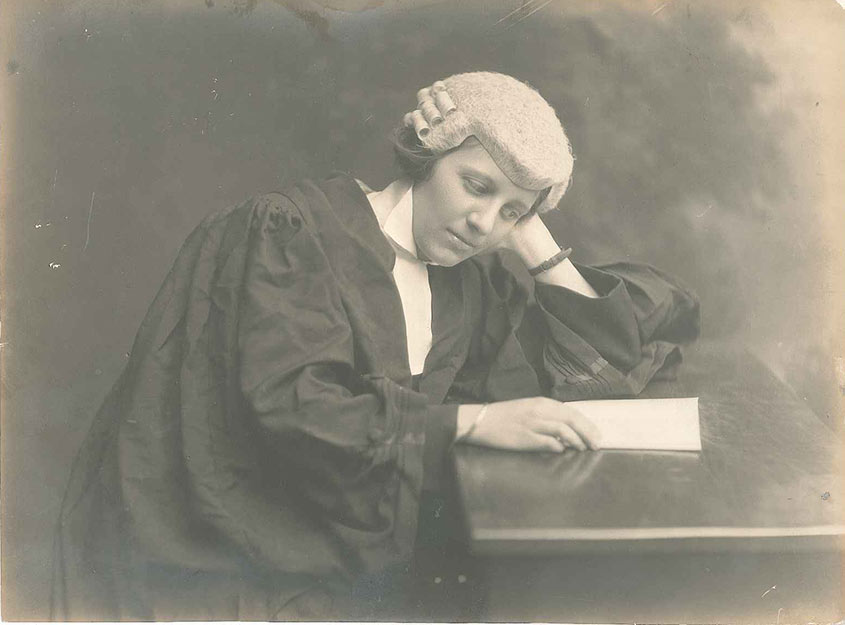
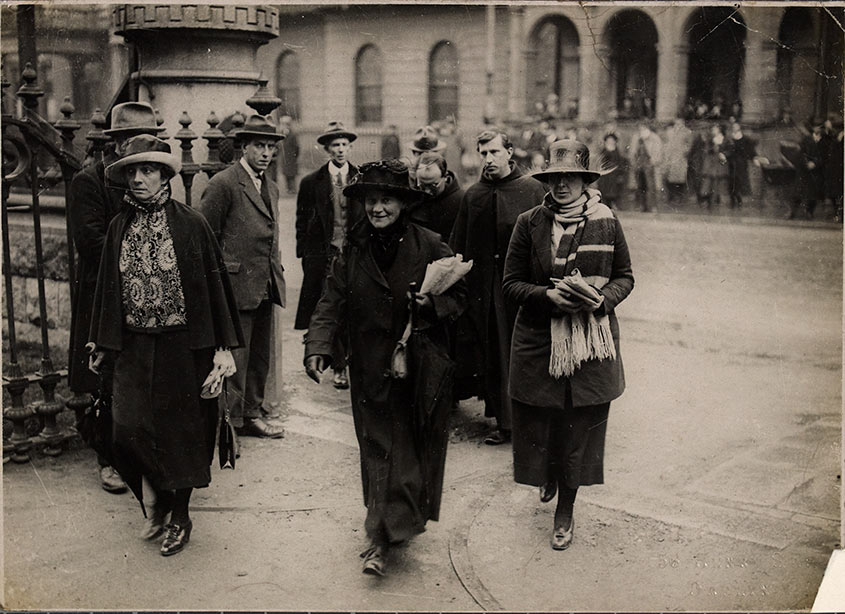
Countess de Markievicz was freed from jail. She was re-appointed Secretary for Labour on 26 August 1921. However, this was no longer a full cabinet post. In the Dáil Kate O’Callaghan stated that she “regretted that the only woman member of the cabinet would not be given cabinet rank in the new arrangement”. Mary MacSwiney stated that by putting out “the only lady member of the cabinet” it was “creating a precedent”.
The first election which took place in the new province of Northern Ireland, two women Julia McMordie and Dehra S. Chicester (Later Dame Dehra Parker) were returned for the Unionist party. They were members of the Ulster Women’s Unionist Council. Members of the UWUC encouraged the registration of voters and held classes on the proportional representation. In the counties of Cavan, Monaghan and Donegal similar work was undertaken by a group known as the Women’s Civic Federation.
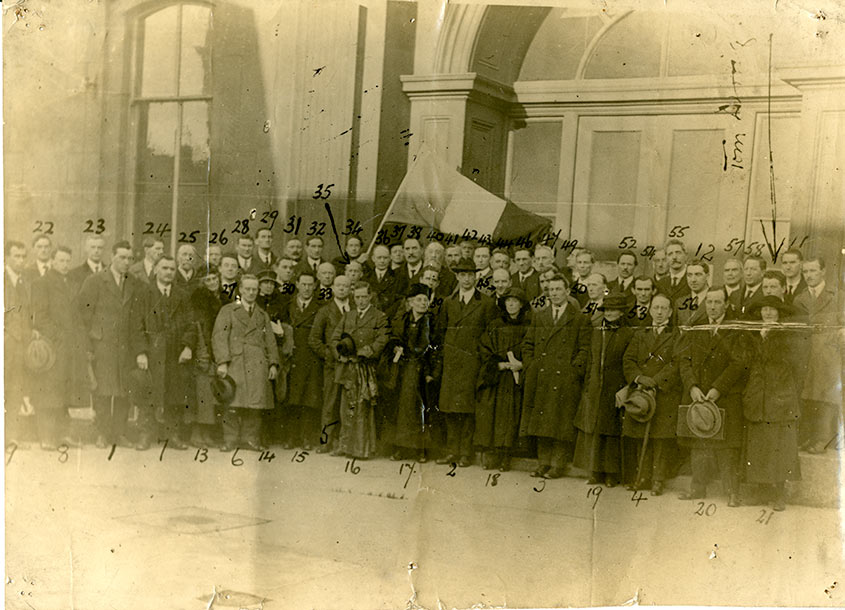
A truce called on 11 July 1921 ended the war of independence. Initial talks between the British Prime Minister David Lloyd George and Éamon de Valera (President of Dáil Éireann) in the summer of 1921, were followed by plenipotentiaries travelling to London to negotiate a settlement, which became the Anglo-Irish Treaty.
The terms of this Treaty caused a split in Dáil Éireann. On 9 January 1922 those who opposed the Treaty left the Dáil chamber, including all six women TDs. Their decision was replicated by the membership of Cumann na mBan who at their convention rejected the terms of the Articles of Agreement by 419 votes to 63. Cumann na Saoirse (Society of Freedom) was then formed by women who supported the Treaty.
On the 14 January 1922 the Pro-Treaty Government set about establishing Saorstát Éireann (The Irish Free State). On the 16 January 1922 the new administration took over Dublin Castle, the seat of British power in Ireland for centuries. A National Army (Óglaigh na hÉireann) and a Civic Guard (later named An Garda Síochána) were formed.
A 3rd Dáil was formed following a general election on 16 June 1922. Two women were elected, Mary MacSwiney for Cork City and Kate O’Callaghan for Limerick City and Limerick East.
Anti-Treaty forces occupied the Four Courts in Dublin. Shelling of the building by Pro-Treaty Troops on 28 June 1922 effectively marked the start of the Civil War conflict. The first sitting of the 3rd Dáil, which was due to assemble on 30 June, was pre-empted by the start of military action.
On 7 July 1922 Caítlín Brugha, was widowed at age forty-three. The mother of six children, made a public request that the women of the Republican movement would act as the chief mourners and the guard of honour at her husband’s funeral.
Her husband Cathal Brugha had opposed the Treaty, but he had tried in vain to stop the escalation of hostilities to civil war. Once warfare commenced he became the commander of forces in O’Connell Street. He was wounded on 5 July, and died two days later.
In the General Election for the 4th Dáil, held on 27 August 1923, Caítlín Brugha stood as a Republican for her late husband’s seat. She topped the poll but did not take her seat. She stood again in the election for the 5th Dáil on 9 June 1927 as a member of Sinn Féin. She remained an abstentionist TD, following her party’s policy of not recognising the legitimacy of Dáil Éireann.
Five women were elected to the 4th Dáil Éireann on 27 August 1923, Caítlín Brugha, Dr Kathleen Lynn, Mary MacSwiney, Countess de Markievicz and Margaret Collins-O’Driscoll who stood for election in North Dublin as a member of the Pro-Treaty party, now known as Cumann na nGaedheal.
Margaret was the eldest sister of Michael Collins. Collins was President of Dáil Éireann and the Commander-in-Chief of the Irish Free State Army when he was killed by anti-treaty forces in an ambush close to his family’s home place in West Cork on 22 August 1922. Margaret left West Cork after her brother’s death. The Civil War which set neighbour against neighbour led to many people leaving the place in which their families had lived for generations.
Margaret served her first term in Dáil Éireann against the backdrop of Civil War. Under the Emergency Powers Act thousands of men and over 700 anti-treaty women, including former TDs Mary MacSwiney and Kate O’Callaghan, were interned. Both of these women obtained early release following hunger-strikes. Countess de Markievicz was also imprisoned and on hunger-strike.
Initially women were imprisoned all over the country, but by late 1923 they were all being held centrally in Dublin. There they were attended to by the first female Commissioned Officer in the Irish Free State Army, Dr Bridget Lyons Thornton. She had fought alongside many of the women in the preceding years. The final female prisoners were released in December 1923. No woman had been executed or died on hunger strike.
In 1924 parliament moved into Leinster House on Kildare Street. Under the terms of the Treaty, Ireland was to have two houses, the Dáil and the Seanad, known as the Houses of the Oireachtas. There were 153 Teachtaí Dála elected using a system of the single transferable vote rather than the British ‘first past the post’ system. The Ministers and Secretaries Act 1924 established eleven Departments of State.
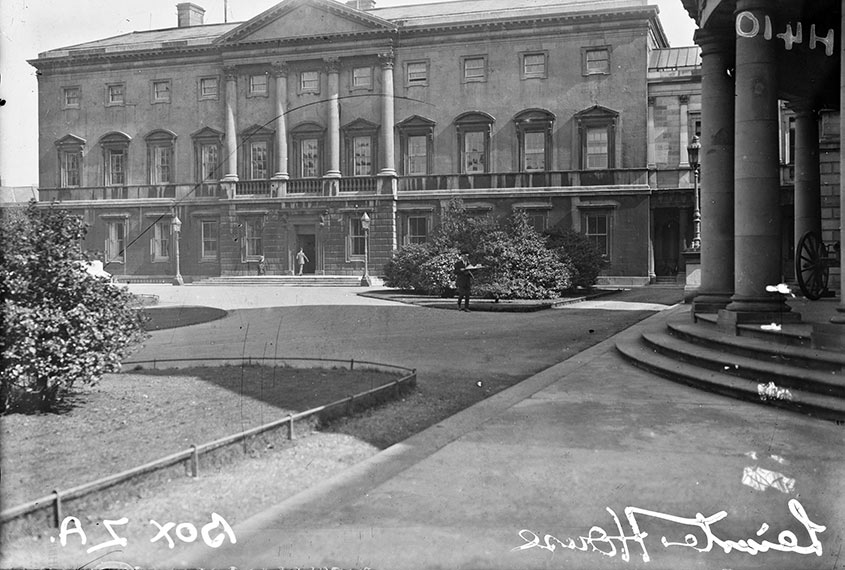
The Constitution of the Irish Free State provided for a senate of 60 members. WT Cosgrave, as President of the Executive Council appointed 30 of these for the first triennial period 1922-1925 and the Dáil selected the remainder.
A Vellum roll, containing the signature of every member of the first Irish Seanad was presented to the Houses of the Oireachtas by Alice Stopford Green.
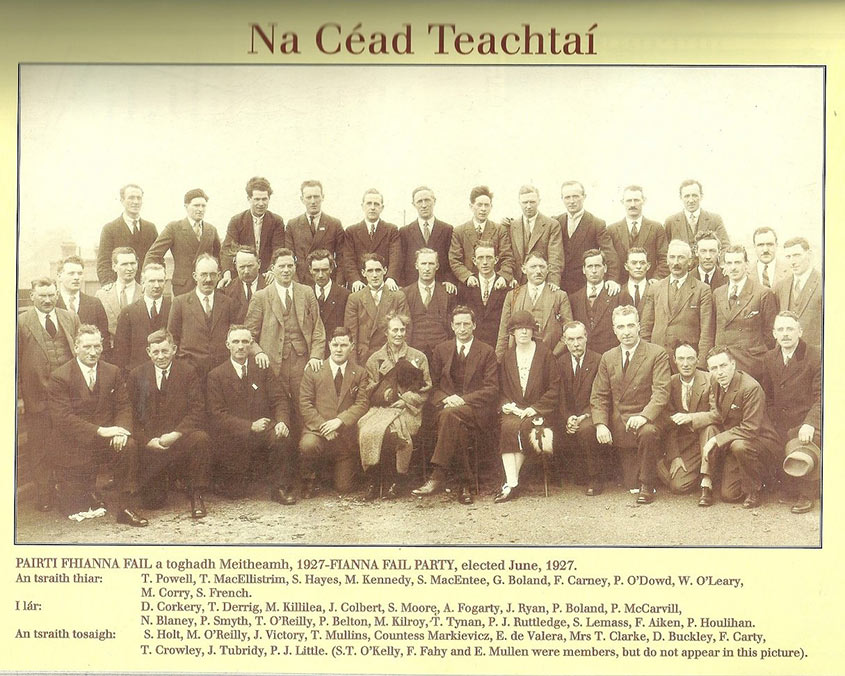
On 29 March 1926 at Rathmines Town Hall ten members of Sinn Féin’s standing committee resigned. Within weeks Éamon de Valera and his supporters had formed a political party they named Fianna Fáil. Its subtitle was the Republican Party.
The inaugural meeting of the party at the La Scala Theatre in Dublin on 19 May 1926 was chaired by Countess de Markievicz. Support for the party grew quickly. A Cumann was set up in each Catholic Parish.
Mary Ryan, a Cumann na mBan member was among the party’s first members in Tipperary. She later recalled that after mass on Sunday at Rear Cross, she and her husband Martin were asked to attend the inaugural meeting of Fianna Fáil. She said: “I did not have to think twice” and joined “there and then”. Mary took responsibility for holding meetings, getting support and raising funds.
On 24 November 1926 it was reported that 500 delegates attended the party’s first Ard Fhéis. Key female supporters included Margaret Pearse, Dorothy Macardle, Hanna Sheehy-Skeffington and Linda Kearns. Kathleen Clarke and Countess de Markievicz were part of the Executive.
Remaining with Sinn Féin, Mary MacSwiney became Vice-President. Her colleague Caítlín Brugha stood as a candidate in the general election for the 5th Dáil in June 1927 and was elected. Kathleen Clarke and Countess de Markievicz were elected for Fianna Fáil but did not take their seats. Once again, Margaret Collins-O’Driscoll of Cumann na nGaedheal was the only female TD in the Dáil.
The fifth International Congress of the Women’s International League of Peace and Freedom was held in Dublin in 1926. 150 delegates attended from 20 countries and it was the first gathering of an international organisation in the Irish Free State.
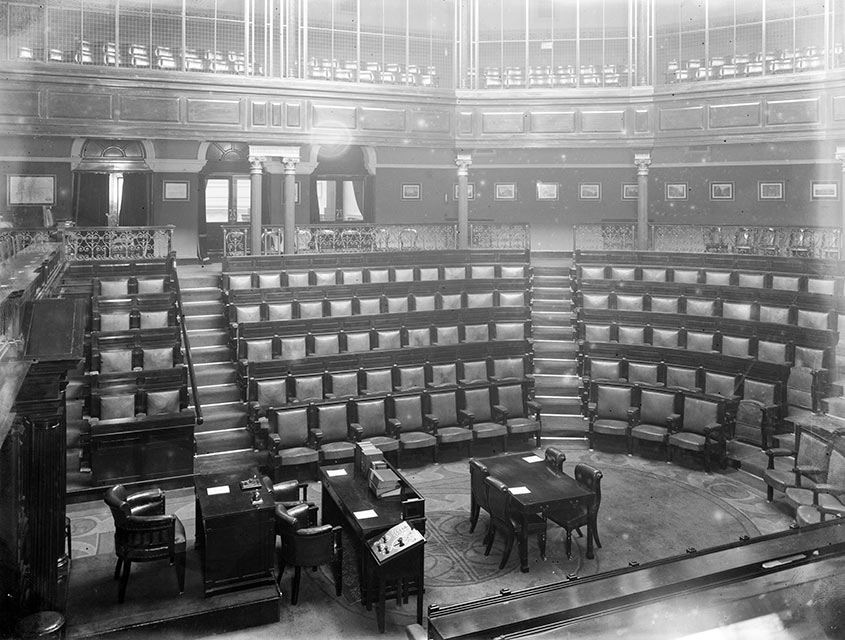
The Juries Act, 1927 declared that juries in criminal and civil cases would be drawn from ratepayers. This meant an almost total exclusion of women. Women were not eligible for jury service unless they specifically applied.
The Electoral Amendment Act (1927) was introduced following the assassination of Minister for Justice, Kevin O’Higgins. The Act provided that candidates for election to Dáil Éireann must sign an affidavit that if elected that they would take their seat and take the oath of allegiance to the monarch within two months. This effectively allowed a mechanism for Fianna Fáil to enter the Dáil. Éamon de Valera persuaded his party to comply stating: “Fianna Fáil deputies hereby give public notice that they propose to regard the declaration as an empty formality and repeat their own allegiance is to the Irish nation …”
Countess de Markievicz was not present – she had died on 15 July 1927. Margaret Collins-O’Driscoll was the sole woman to sit in the 6th Dáil.
In December 1928 Kathleen Clarke representing Fianna Fáil, joined Eileen Costello, Ellen, Countess of Desart, Alice Stopford Green and Jennie Wyse Power in the Seanad.
Sinn Féin members continued to hold meetings of the 2nd Dáil. It was, in their view, the legitimate assembly elected and never dissolved. They continued to publicise its existence and met on a regular basis. Newspapers called it ‘Miss MacSwiney’s Dáil’. It was also attended by Kate O’Callaghan and Dr Ada English.
Lady Mary Bailey born in County Monaghan became the first woman to fly solo from London to Cape Town. She became known as ‘champion airwoman of the world’.
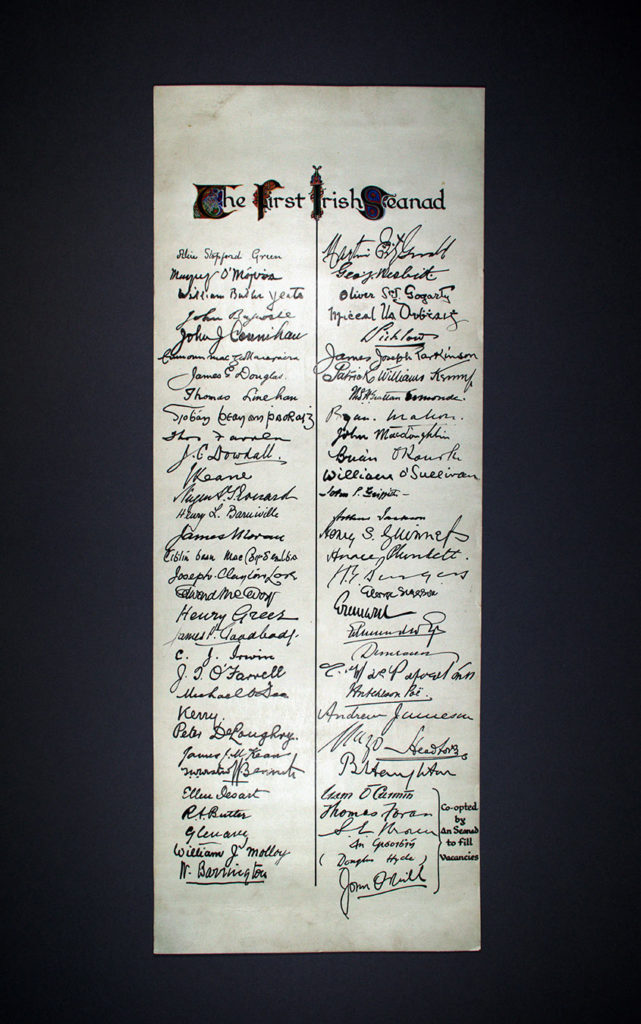
Censorship of Publications Act, 1929 was passed. This provided for the creation of a Censorship Board. It also provided for a mandatory ban on books or periodicals advocating ‘unnatural prevention of conception’.
Máiréad Ní Ghráda was the first woman radio announcer. She retained the role of the principal announcer in Radio Éireann from 1929 until 1935.